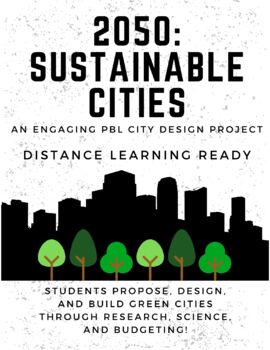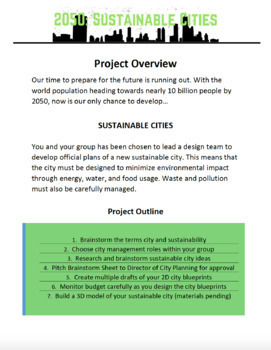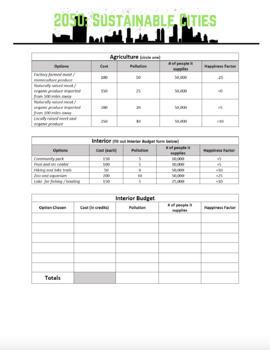2050: Sustainable Cities -- City Design Project
- PDF
- Easel Activity
What educators are saying
Description
2050: Sustainable Cities -- City Design Project
Background Information
Sustainable Cities is a collaborative project-based learning activity in which students brainstorm and design a green city from scratch! In collaborative groups, students choose roles as various city planners to design a "fully functional" sustainable city. This project is incredibly relevant today with climate change being a serious global threat to human societies.
The project utilizes various student abilities and interests ranging from scientific inquiry to creative design. Students are asked to do the following over the course of 1-2 weeks:
- Brainstorm key vocabulary words
- Choose city management roles
- Research sustainable innovations and inventions
- Communicate with the Director of City Planning (Teacher) closely
- Create drafts of their 2D city blueprints
- Carefully monitor their budget throughout the project
- Build a 3D model of their city (depending on availability of materials)
Project materials include...
- introductory discussion questions
- brainstorm sheet
- graphic organizers
- detailed budget sheet
- teacher grading rubric
- teacher notes
- links to supplemental videos and materials
Perfect for...
- online learning and distance learning
- climate change lessons and sustainability lessons
- project-based learning (PBL) classrooms
- high school (9th, 10th, 11th, and 12th grade)
- units on sustainability, environmental science, engineering, and economics
- building collaboration, communication, and design skills
- end of the year AP Environmental Science project
- online learning and distance learning
- Can be used as an online learning resource, distance learning, or in-person - includes fillable PDF so you can assign it to your Google Classroom
Looking for more? Check out our related products!
The Climate Change Agreement -- Paris Agreement Role Playing/Simulation
Sea Level Rise Analysis -- Climate Change and Sustainability -- PDF VERSION
Krazy For Kelp -- Marine Ecosystem and Sustainable Seaweed Farm Design Project
Mission To Mars -- PBL Space Exploration and Mars Colony Design
Sustainable CEOs -- Build a Sustainable Business
Want updates?
Be sure to click the green star on my store page to follow me and be the first to know about new and updated products!






